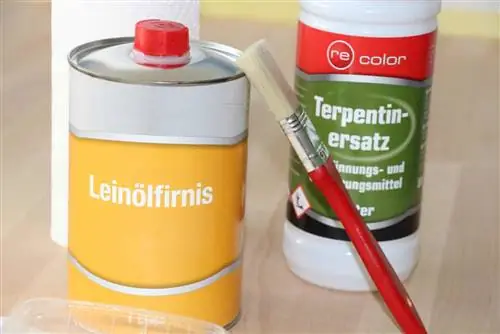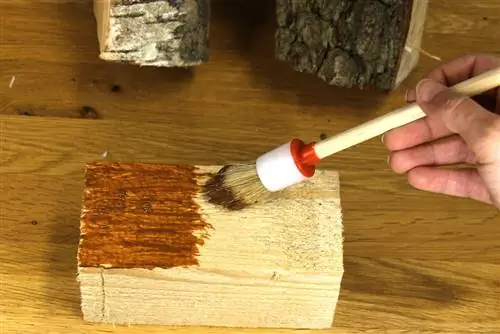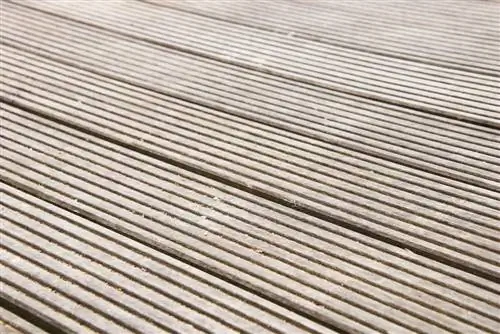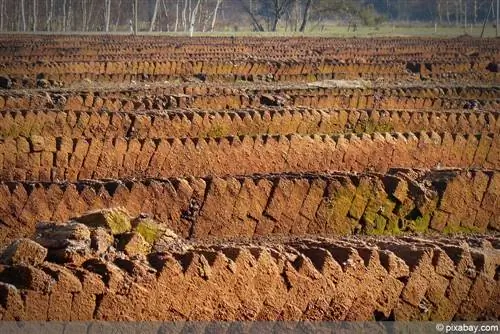- Author admin [email protected].
- Public 2023-12-17 03:39.
- Last modified 2025-06-01 06:48.
Whether in the garden or house, wood is a popular building material. However, if it is used outdoors, it requires a certain amount of protection from wind, weather and sun. If there is no other coating, wood care oil is a good alternative. Below you will find out what types there are and how to use them.
What is wood care oil?
To understand the different types of oil and their application, it is first important to know the general properties of wood care oils:
- Does not form a layer on the surface
- Therefore no additional protection against mechanical abrasion, wear etc.
- Penetrates the wood pores and leads to saturation of the upper layer of wood
- Maintains breathability and diffusion openness
- Does not affect the feel and surface quality
- Optical changes, such as darkening and color, possible depending on the type of oil
The ingredients
Generally speaking, wood care oil consists of up to four ingredients:
- Binder
- Solvents
- Additives
- Pigments
The area of additives and pigments in particular is very variable and can even be omitted completely. The focus, on the other hand, is primarily on the binding agent, i.e. the substance that remains in the wood pores after it has completely dried and produces the protective effect.
The binders
Two different groups of substances have established themselves as common binders:
- Vegetable oils in natural form, e.g. linseed oil, soybean oil, sunflower oil or tall oil
- Modified oil, so-called alkyd resin, usually based on linseed oil or oil mixtures
Both oil groups are comparable in terms of their protective effect, so that from a technical point of view there is no significant difference in the pure selection of the “crude oil” on which the wood care oil is based. A special orientation of a product is usually only achieved when all ingredients are taken together, i.e. the oil combinations and the additives.
The solvents
Next we look at the common types of solvents. Generally speaking, they are required in wood care oil in order to make the generally viscous oils used as binders usable. They can be described as completely uncritical for outdoor use, as evaporated solvents can evaporate without any problems and do not lead to enrichment of the ambient air.

Linseed oil varnish is usually used in combination with natural oils. Despite being used as a solvent, it is not a volatile substance, but dries in a comparatively long time. Modified oils, on the other hand, are usually combined with isoparaffins or gasoline. These real solvents evaporate relatively quickly after processing, allowing the oiled surface to be used quickly. In very rare cases, water can also be found as a solvent, although these products hardly make a significant appearance in the mass of products available on the market.
The solvent proportions
- Solvent-free oils: close to 0%, but never completely missing, as they are also necessary for drying additives
- Other care oils: up to proportions of 40 to 60%
- Comparison: Varnishes up to 80% !!
ATTENTION:
Aliphatic / aromatic hydrocarbons are often found as solvents, especially in products of unclear origin. However, they are known to be dangerous to he alth and should therefore be avoided.
Additives
If additives are added to wood oil, these are substances that change a wide variety of aspects:
- drying accelerator
- Additionals for a matt or shiny look
- Additives to create the protective film on the surface that is not present with oil
The drying
Wood care oil is usually dried oxidatively. This means that the molecules in the oil react with the oxygen in the air and create long-chain compounds - they harden. The term hard oil is often used for oil products, although ultimately there is no difference between care oils with this name and oils without this name. Drying accelerators are usually added to modified oils, although natural oils are also increasingly using them in order to survive on the market. The resulting drying times are usually in these ranges:
- With accelerating additives: approx. 24 to 48 hours
- Without accelerator: 1 to 3 weeks
The protective film - hard wax oil
The most common and most recognizable additive to wood care oils for the end user is wax. Many of these products are available as hard wax oil, as well as under similar names. The added wax is intended to replace the protective film on the wood surface that is actually not present with oil. While the care oil penetrates deep into the wood pores, the wax settles on the wood as a slightly shiny layer and replaces, at least to a limited extent, the protective effect that is normally created by varnishes or glazes. However, the layer formation of the wax never comes close to that of varnishes or glazes and must be renewed regularly due to its significantly lower durability.
Tip:
If you want to give your wood a waxed look, hard wax oil is a good option that allows it to be processed when it is cold. In its pure form, however, wax can usually only be processed when heated.
Pigments
Many care oils are given product names such as “teak oil”, “Bangkirai oil” or similar. Even if one might initially assume that these are oil recipes created specifically for these types of wood, in the end it is all about the pigmentation, which is based on the namesake wood species. Unpigmented oil is usually colorless or only slightly colored. For example, linseed oil produces a slight yellow tinge. Only by adding dyes are the oils able to emphasize the natural wood tone of a type of wood or give other types of wood the appearance of a desired wood. It is not unusual, for example, for terraces or garden furniture to use cheaper woods, which are then “upgraded” by using teak oil.
The right oil - selection

With this knowledge about the differences between the individual wood care oils, you can easily choose the right oil for your own needs from the limited range available at specialist stores. You should keep the following questions in mind:
- Time required: Is there a waiting time or oil with drying accelerators?
- Surface: film-forming hard wax oil, or pure care oil?
- Optics: Only care effect desired, or emphasis or change of color through pigmented oils?
- Gut feeling: Natural oil or “synthetic” alkyd resin?
The processing
Once you have decided on a wood care oil, it is time to process it. It is the same for all types of oil, so that the application can be described here universally:
- Applying an oil film to the wood with a brush or cloth
- Wait for the exposure time according to the manufacturer’s instructions
- Rub any oil remaining on the surface with a cloth and wipe off excess
ATTENTION:
If you use pure or almost pure linseed oil for wood care, you should water the cloth you used after completing the work and seal it airtight in a plastic bag. The massive fumes from the linseed oil residues in the rag can self-ignite under favorable conditions (strong sunlight, etc.) when they come into contact with atmospheric oxygen! However, there is no danger for the oil applied to the wooden surface.
Common errors
Although the processing of wood care oils is very simple, elementary mistakes are made again and again, which primarily affect the subsequent appearance of the surface:
- too little oil on the wood, resulting in stains due to dried out areas with less oil
- Oil not rubbed and wiped off, resulting in stained surface due to remaining oil drops
- Oiled surface walked on too early: stains and streaks due to dirt, and damage to garden paths etc. possible due to care oil on shoes (especially absorbent types of stone)






